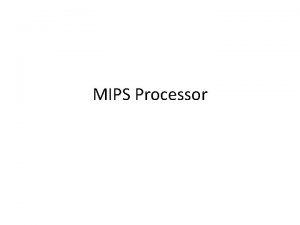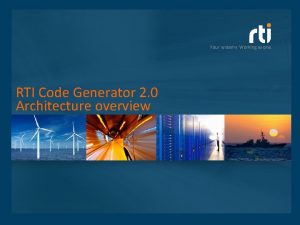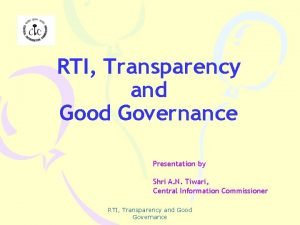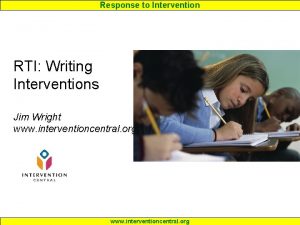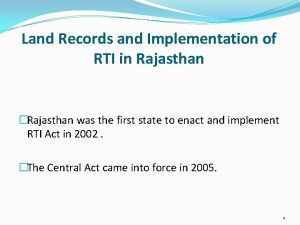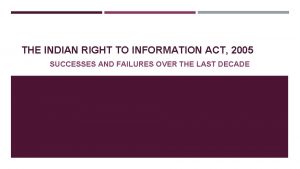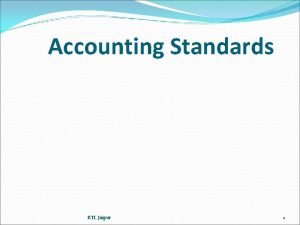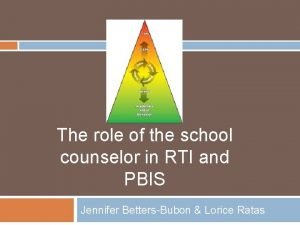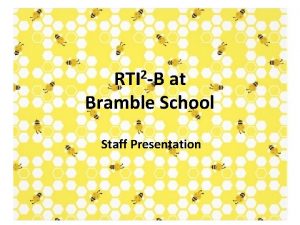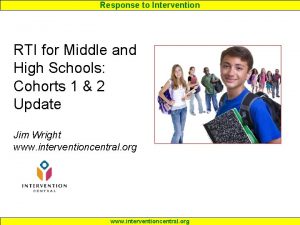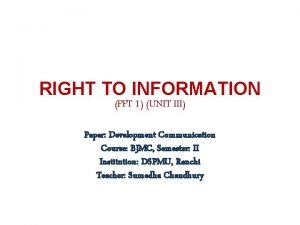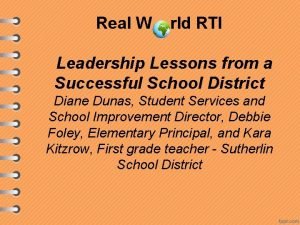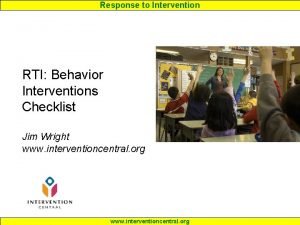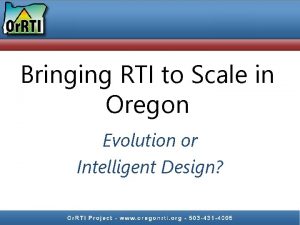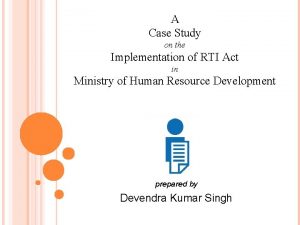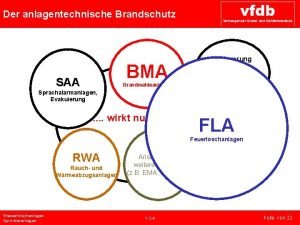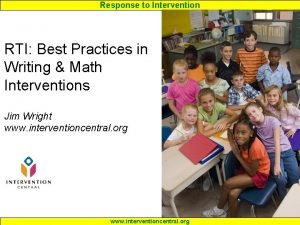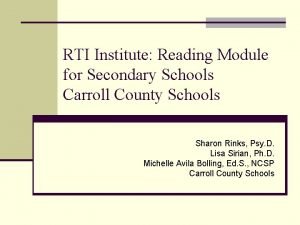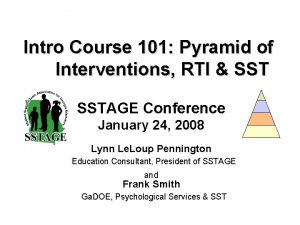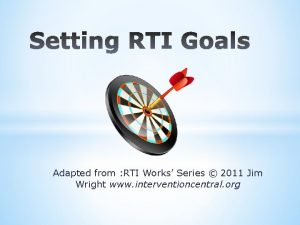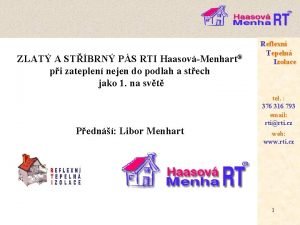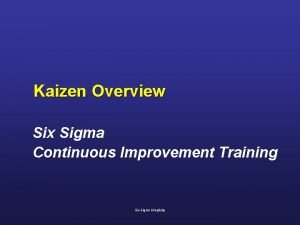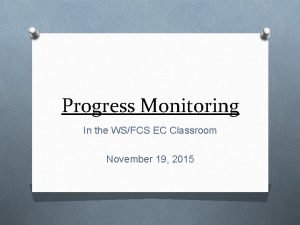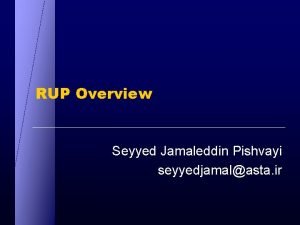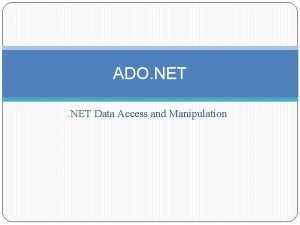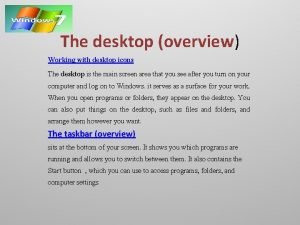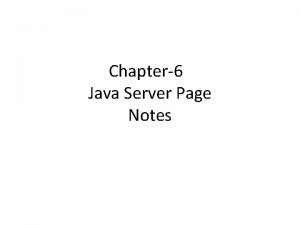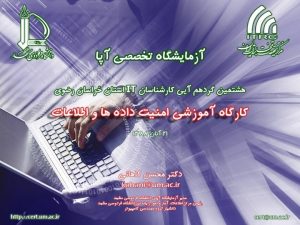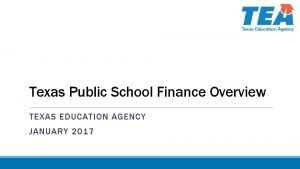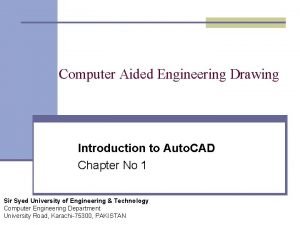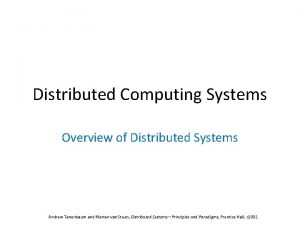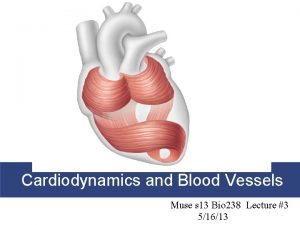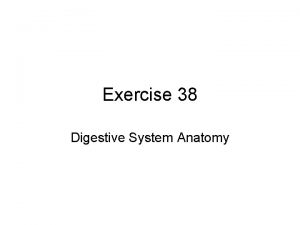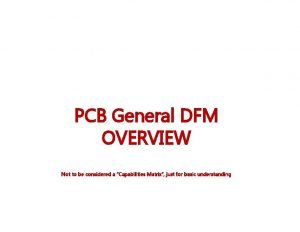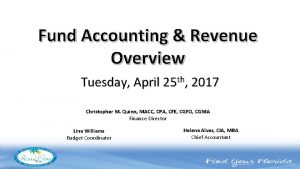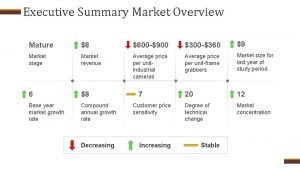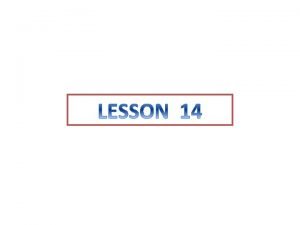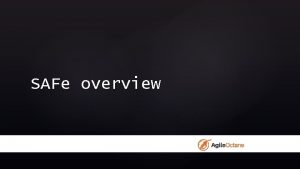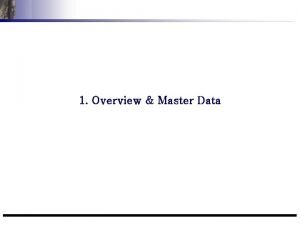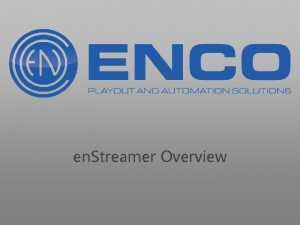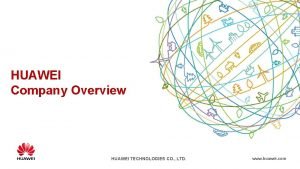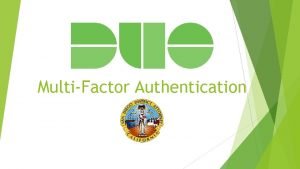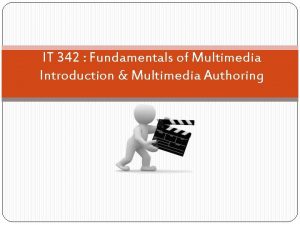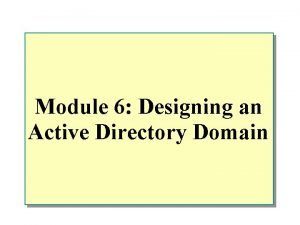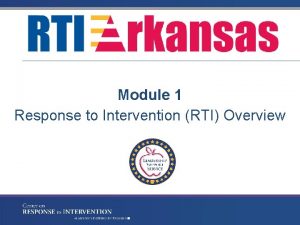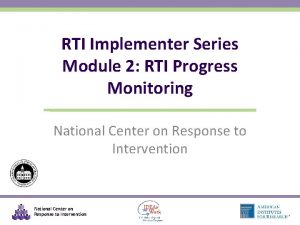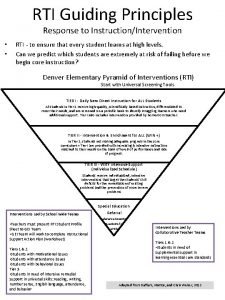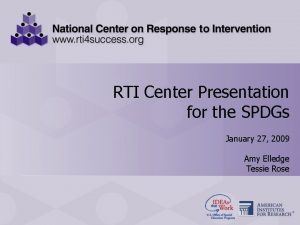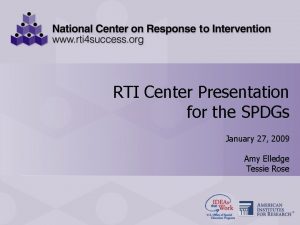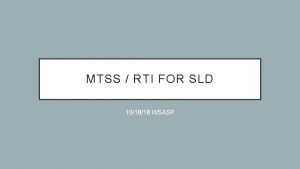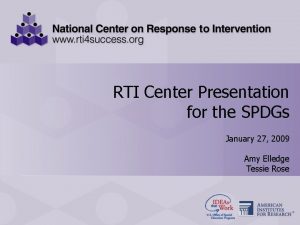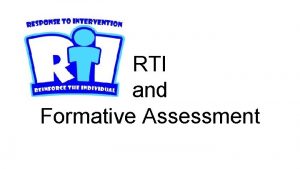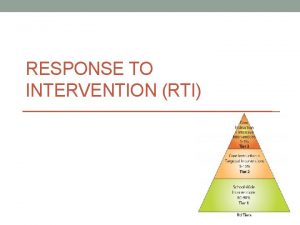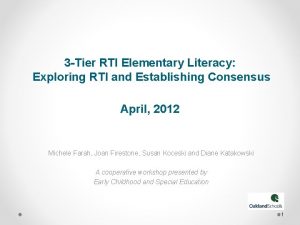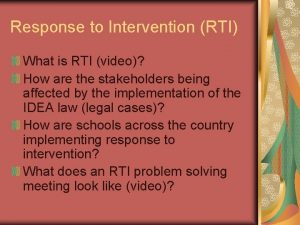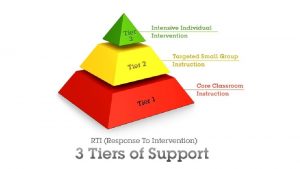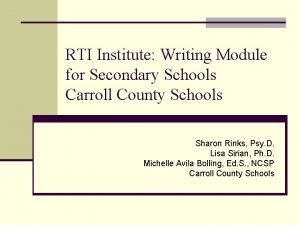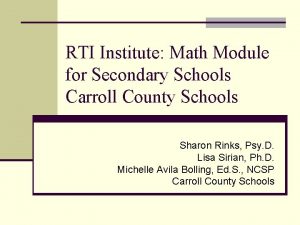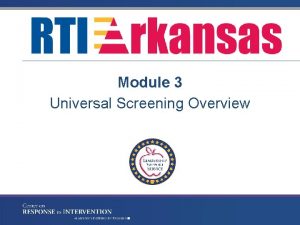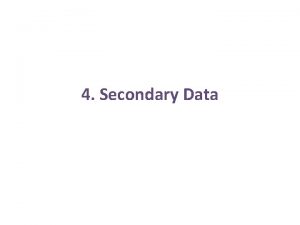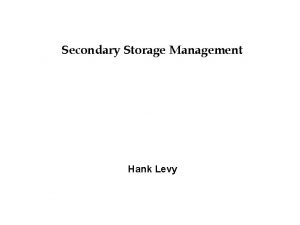Module 11 Overview of Secondary RTI Implementation Secondary
















































































- Slides: 80

Module 11 Overview of Secondary RTI Implementation

Secondary RTI Series Overview Module 11: Overview of Secondary RTI Implementation Module 12: Early Warning Systems in Secondary Education Module 13: Evidence-Based Practice Across the Tiers in Secondary Education 2

Module 11 Objectives Participants will be able to: ▪ Identify benefits of RTI implementation in high school. ▪ Explain the essential components of RTI implementation at the secondary level. ▪ Explain the five Institute of Educational Services (IES) recommendations for improving literacy outcomes for secondary students. ▪ Refine the schoolwide plan to improve instruction and screening implementation at the secondary level. 3

THINK-PAIR-SHARE ▪ What do you think about when you hear Response to Intervention, or RTI? ▪ What questions do you have about RTI? Discuss 4

Overview of RTI 5

Defining RTI integrates assessment and intervention within a schoolwide, multilevel prevention system (i. e. , multi-tiered system of support, or MTSS) to maximize student achievement and reduce behavior problems. Source: National Center on Response to Intervention. 6

RTI—Who Does It Serve? RTI is not a special education initiative; it is an educational initiative for all students, including those at risk, students with language differences, and students with disabilities. 7

Essential Components of RTI 8

RTI Arkansas Model 9

RTI at All Grade Levels Focus Outcomes Elementary School ■ Prevention of poor learning outcomes ■ Schoolwide, early intervention ■ Improvement in basic literacy and math skills ■ Appropriate identification of at -risk students Middle School ■ Dropout prevention ■ Prevent poor learning outcomes in HS ■ Prepared for HS success ■ Credits/Proficiency on state exams High School ■ Dropout prevention ■ Supplemental intensive support ■ Content recovery ■ Targeted grades/populations ■ Improve graduation rate ■ Pass core courses/exams 10

Note Taking Resource Workbook Activity 11

Why RTI in Secondary Settings? 12

% AR Students Meeting College Readiness Benchmarks Discuss 13

AR Average ACT Score Science Benchmark (23) Math and Reading Benchmark (22) English Benchmark (18) Discuss 14

Why RTI in Secondary Settings? Prevention of Negative Consequences Proficiency in Literacy 15

RTI Focus Area for Secondary Setting ▪ Elementary RTI models are NOT considered appropriate for secondary schools. ▪ Before implementing RTI in secondary settings, teams must determine the focus of implementing an RTI model. • If prevention, which negative consequences will be the focus of the prevention efforts? • If proficiency, what areas move students toward proficiency? 16

What Outcomes Are the Focus of Secondary RTI Models? Broad Outcomes ■ Increase graduation rates ■ Prevent school dropout ■ Increase proficiency in basic literacy and math skills ■ Reduce behavior problems Specific Outcomes Identified through Data Analysis ■ Increase assignment completion ■ Improve attendance ■ Improve reading comprehension 17

Creating a Focus Statement ▪ What negative outcomes identified in our data would we like to focus on preventing? ▪ In what literacy areas are students not yet proficient, as suggested by our data? We are implementing RTI to ___[result of efforts]______ because our data suggest __[outcome of concern]____. Workbook Activity 18

Potential Root Causes ▪ Why are students struggling to achieve the identified outcomes? Our analysis suggests that students are struggling with __[outcome of concern]__ because of the following: __[potential causes]___. Workbook Activity 19

Essential Component: Screening 20

What is Screening? Process of using brief assessments at least three times per year (i. e. , fall, winter, spring) with all students in a grade level followed by additional testing or short-term progress monitoring to corroborate students’ risk status and to identify or predict students who may be at risk for poor learning outcomes 21

Purpose of Universal Screening ▪ Identify students at risk for poor learning outcomes ▪ Identity students who need additional assessment (i. e. , progress monitoring) and instruction (i. e. , secondary or tertiary) ▪ Provide data on the effectiveness of the core instruction, curriculum, and interventions 22

Key Features of Universal Screening ▪ Provides an indicator of risk status ▪ Uses valid and reliable tools designed for efficient administration and scoring ▪ Uses standardized tools and processes ▪ Identifies areas of need and improvement ▪ Designed as a formative, not diagnostic, assessment tool for monitoring growth (sensitive to change) ▪ Part of a comprehensive data system that provides easy access to reports at all levels of instruction 23

Screening is a Two-Stage Process ■ Stage 1: Brief assessment administered to all students to identify those at-risk ● Early Warning System (All Students) ■ Stage 2: For students identified as at-risk, additional data are used to more accurately predict which students are truly at risk for poor learning outcomes ● Academic, Social Emotional, and Behavior Screeners/Progress Monitoring (At-Risk Students) 24

How do Secondary Schools Screen? ■ Early Warning System ● comprehensive system ● uses multiple variables to predict at-risk students ● recommended approach for grades 7 and up ■ Academic and Behavior Screeners ● identifies students who are struggling ● less predictive of graduation or post-school success ● part of a comprehensive early warning system (not a stand alone tool) 25

Early Warning Indicators ▪ Indicators that are highly predictive of a student’s likelihood of dropping out of school or not graduating in four years: Attendance Behavior (suspension) Course Proficiency (GPA) 26

Early Warning Indicators: th th 6 – 12 Grades More than 9 absences per quarter, Total of 36/year 6 7 8 9 X X 10 11 12 Missed 10% or more of instructional time X X Locally valid behavior data X X Office referrals: More than 2 per quarter/6/year X X More than 1 suspension per quarter/2 per year X X <2. 0 GPA on 4. 0 scale X X One or more course failures (any) X X X X One or more course failures On-track indicator – core course failure(s) AND credit deficient for promotion X X John Hopkins University, 2012 27

Screening Using Early Warning and Monitoring Systems 28

Published Academic Screeners Tools for Selecting Academic Screening Tools: National Center on Intensive Intervention (NCII) Academic Screening Tools Chart. 29

Academic Screening Assessment Windows Fall Winter ■ Initial Screen ■ Screen students ■ Typically who were absent conducted after 1 for initial screen -2 weeks of ■ Provides data on instruction at-risk status ■ Month: changes September ■ Month: January Spring ■ Provide data used in planning for next school year and evaluate overall impact ■ Month: May Schools should limit the screening testing window two weeks or less 30

TEAM REFLECTION: Screening ▪ How might your district and/or school implement screening? What are the benefits and challenges? ▪ If you already have a screening practice, how are the data and results meeting your needs? Workbook Activity 31

Essential Component: Progress Monitoring 32

Why Progress Monitoring? “When teachers use systematic progress monitoring to track their students' progress in reading, mathematics, or spelling, they are better able to identify students in need of additional or different forms of instruction, they design stronger instructional programs, and their students achieve better. ” Fuchs & Fuchs, 2002, p. 1 33

What is Progress Monitoring? Repeated measurement of student performance over the course of intervention to index/quantify responsiveness to intervention and to thus determine, on an ongoing basis, when adjustments to the program are needed to improve responsiveness Progress Monitoring Tools Progress Monitoring Process National Center on Intensive Intervention, 2017 34

Progress Monitoring Data Compare the efficacy of different forms of instruction Estimate the rates of improvement (ROI) across time Data allow us to… Identify students who are not demonstrating adequate progress Determine when an instructional change is needed 35

Example of PM Tools Tier Measures Frequency 1 • • • Ongoing formative assessments Common math assessments Common writing prompts Grades Attendance Behavior data • • • Daily Monthly Semester/quarterly First 20 days of school 2 • • • Teacher developed algebra CBMs D/F reports Time-sampling for behavior • • • Every other week Weekly 3 • • • Intervention specific measures Individual behavior tracking sheets Direct Behavior Ratings (DBR) • • Daily/Weekly Daily 36

TEAM REFLECTION: Progress Monitoring ▪ What assessments and tools will you use or do you use to measure each content area and level of intervention? ▪ With what frequency do you need to collect student data for Tiers 2 and 3 intervention? Workbook Activity 37

Essential Component: Data. Based Decision Making 38

What Is DBDM? A problem-solving process of collecting and analyzing a common set of data to: ▪ Identify areas of need ▪ Set measurable goals ▪ Analyze and hypothesize root causes of problem areas ▪ Identify and implement research-based strategies to address specific areas 39

Four-Step Problem-Solving Method 1. Define the problem and set the goal 2. Analyze the problem and hypothesize 3. Develop and implement the plan 4. Evaluate the plan Elliott, 2016 40

Decision Making: Tier I System. Level DBDM Student. Level DBDM 41

Outcomes of DBDM at Tier I ▪ Evaluate the overall effectiveness of the Tier 1 curriculum and instruction ▪ Evaluate the effectiveness of the curriculum and instruction for subgroups ▪ Identify areas of system improvement ▪ Support development of system-level interventions and measurable goals ▪ Identify students who need additional assessment and intervention 42

Decision Making: Tiers 2 and 3 System. Level DBDM Student. Level DBDM 43

Outcomes of DBDM at Tiers 2 and 3 ▪ Evaluate students’ response to Tiers 2/3 intervention ▪ Identify students who need additional diagnostic assessment and intensive intervention ▪ Evaluate the overall effectiveness of the RTI system at Tiers 2 and 3 44

TEAM REFLECTION: Data-Based Decision Making ▪ What types of data will you or do you use to make databased instructional decisions? ▪ To what extent are teams using and analyzing screening data? What are the strengths? What areas for improvement? Workbook Activity 45

Multilevel Prevention System 46

RTI Arkansas Model 47

Varying Evidence Standards 48

Varying Evidence Standards Research-Based Evidence-Based • Recommended for Tier 1 • Recommended for Tier 2 across subjects and Tier 3 • Components have been • Materials evaluated using researched and found to rigorous research design be generally effective • Evidence of positive • Curriculum materials effects for students who have not been rigorously received the intervention evaluated as a package 49

Tier I Characteristics Focus All students (including students with disabilities and learning differences) Instruction Setting Assessment District core General curriculum and education instructional classroom practices are research based, aligned with state or district standards, and incorporate differentiated instruction Screening, continuous progress monitoring, and outcome measures or summative assessments 50

Elements of Effective Tier I Instruction ▪ ▪ Schedule and use of time Clear academic and behavioral expectations Standards-based materials High-leverage instructional practices and evidence-based practices ▪ Differentiated instruction ▪ Inclusion of students with disabilities and those exceeding benchmarks 51

Differentiated Instruction In an effective RTI model, teachers • use student data to identify and address the needs of students • differentiate instruction for students on, below, or above grade level by creating multiple paths for students to equally experience learning 52

Features of Differentiation ▪ ▪ ▪ Uses teacher modeling Scaffolds student responses Presents information in multiple formats Offers choice Provides multiple response opportunities Presents opportunities for students to direct their own learning Discuss 53

What Are Differentiated Learning Activities? ▪ Differentiation involves— • • • Mixed instructional groupings Team teaching Peer tutoring Learning centers Accommodations to ensure that all students have access to the instructional program ▪ Differentiation is not the same as providing more intensive interventions to students with learning disabilities 72

Supplemental and Intensive Instructional Focus ▪ Students identified through screening as at-risk for poor learning outcomes; verified by progress monitoring or other data ▪ Typically, 10 percent to 15 percent of the entire school population receives supplemental intervention and 1 percent to 5 percent receives intensive intervention ▪ At the high school level, a problem-solving approach should be used if the failure rate in any course, especially core courses, is greater than 10 percent 55

How are Secondary Schools Scheduling Interventions? ▪ ▪ Using elective periods Adding an additional class period Providing extended learning time Providing interventions within core class block 56

TEAM REFLECTION: Tiered System of Support ■ To what extent are we implementing a tiered system of support in content area classes? What are our strengths? What areas for improvement? Workbook Activity 57

Implementing RTI: Benefits and Concerns Potential Benefits Potential Challenges Workbook Activity 58

Contextual Factors Impacting RTI Implementation in Secondary Settings 59

Contextual Factors Impacting RTI In Secondary Settings ▪ Graduation requirements/Credit-based system ▪ Scheduling ▪ Staff capacity ▪ Access to evidence-based programs ▪ Student involvement 60

Credit-Based System ▪ Challenges • Lacks the flexibility of moving in and out of ‘intervention classes’ • Students receiving academic intervention miss classes required for graduation • Intervention classes are not credit bearing or do not count toward college admission Recommendation: Reduce the need for supplemental support through high quality Tier 1 core instruction and differentiation. 61

Scheduling ▪ Challenges • Finding time to analyze/discuss student data, and plan instruction and intervention with teachers and students • Allocating sufficient time for implementation • Creating flexible schedules or adapting the master schedule Recommendation: Include data review and intervention planning time in the master schedule (e. g. , PLCs). Consider master schedule approaches that allow embedded intervention time. 62

Staff Capacity ▪ Challenges • Building teacher knowledge • Supporting implementation through coaching • Providing teachers time to problem solve, collaborate with colleagues, and provide/receive coaching Recommendations: Plan for adequate professional development and coaching to support implementation. Start small and focus on powerful practices! 63

Access to Evidence-Based Programs ▪ Challenge • Limited evidence for literacy and math intervention programs at secondary level Recommendations: Use available resources, like IES Practice Guides and state provided resources, to develop and implement effective programs. 64

Student Involvement ▪ Challenges • Higher levels of disengagement for struggling high school students • Students often don’t see the value of ‘interventions’ Recommendation: Share screening data with the identified student. Problem solve with the student about why he/she is struggling and what interventions and supports would help. 65

TEAM REFLECTION: Contextual Factors ▪ ▪ ▪ Graduation requirements/Credit-based system Scheduling Staff capacity Access to evidence-based programs Student involvement Which contextual factors do you view as the most challenging? What steps can the team take to address these challenges? Discuss 66

Tier 1 Effective Practices for ALL Secondary Teachers 67

Schoolwide Literacy Recommendations Literacy What would this What are we already Recommendation look like in doing related to this secondary? recommendation? Workbook Available or Needed Resources Activity 68

Improving Adolescent Literacy: Key Recommendations From the IES Practice Guide 69

Summary of Evidence Tier 1 Literacy Recommendations Evidence ■ Provide explicit vocabulary instruction. STRONG ■ Provide direct and explicit comprehension STRONG strategy instruction. ■ Provide opportunities for extended discussion of text meaning and interpretation. MODERATE ■ Increase student motivation and engagement in literacy learning. MODERATE 70

Schoolwide Literacy Recommendations Literacy What would this What are we already Recommendation look like in doing related to this secondary? recommendation? Workbook Available or Needed Resources Activity 71

Team Learning Activity 1. Select two recommendations to focus on or learn more about. 2. Divide your team into two groups and assign each group one of the two strategies. 3. Read, with your group, the assigned recommendation and prepare to share (15 minutes). Think of this as a deep dive! Workbook Activity 72

Team Learning Activity 4. Teach your peers (5 minutes each): • Key findings/components of the recommendation • Recommendations for implementation • Potential roadblocks and solutions 5. Discuss the following (15 min) • What recommendation best addresses the iidentified needs? • Which recommendation is feasible given our current context? • What actions do we take to move forward with implementing the recommendation? • What supports or resources do we need to be successful? Workbook Activity 73

Schoolwide Literacy Recommendations Literacy What would this What are we already Recommendation looks like in doing related to this Secondary? recommendation? Workbook Available or Needed Resources Activity 74

Team Action Planning 75

Considerations for Action Planning How will you… ▪ Implement a process to identify students at-risk (screening) ▪ Communicate RTI efforts with staff ▪ Implement a plan for core content literacy strategies ▪ Build RTI knowledge of teachers and staff Workbook Activity 76

Action Planning Resources Workbook Activity 77

Closing and Next Steps 78

Reflect and Plan: ▪ What are two a-ha’s or things that clarified my thinking? ▪ What questions do I still have? ▪ What will I do with what I learned? • Identify 2 -3 immediate and future next steps 79

Resources to Support Implementation National Center on Intensive Intervention Teaching Works www. teachingworks. org www. intensiveintervention. org CEEDAR Center High Leverage Practices in Special Education http: //ceedar. education. ufl. edu/ www. highleveragepractices. org What Works Clearing House https: //ies. ed. gov/ncee/wwc/ Center on Response to Intervention www. rti 4 success. org 80
 Mips implementation overview
Mips implementation overview Rtiddsgen
Rtiddsgen Rti and good governance
Rti and good governance Jim wright intervention central
Jim wright intervention central Rti zeromq
Rti zeromq Rti portal rajasthan
Rti portal rajasthan Rti act 2005 introduction
Rti act 2005 introduction Rti jaipur
Rti jaipur Rti school counseling
Rti school counseling Rti 2
Rti 2 Upper respiratory tract
Upper respiratory tract Rti scheduler
Rti scheduler Pegasus pensions
Pegasus pensions Hmrc rti gtax
Hmrc rti gtax Right to information act 2005 ppt
Right to information act 2005 ppt Serp.louisiana.doe
Serp.louisiana.doe Rti meaning real estate
Rti meaning real estate Rti behavior checklist
Rti behavior checklist Rti oregon
Rti oregon Rti case study
Rti case study Trockenalarmventilstation
Trockenalarmventilstation Rti interventions list
Rti interventions list Subsplease.orf
Subsplease.orf Heraus ragen
Heraus ragen Rti interventions examples
Rti interventions examples Jim wright rti
Jim wright rti Rti izolace
Rti izolace C device module module 1
C device module module 1 Psalms overview
Psalms overview Kaizen alternatives
Kaizen alternatives Wsfcs overview
Wsfcs overview Maximo overview
Maximo overview Rup overview
Rup overview Ado.net overview
Ado.net overview Collection of programs written to service other programs.
Collection of programs written to service other programs. Common desktop icons
Common desktop icons Vertical retail
Vertical retail Grid computing introduction
Grid computing introduction Introduction product overview
Introduction product overview Jsp overview
Jsp overview Azure blob storage price
Azure blob storage price Asvs owasp
Asvs owasp Overview of airport operations
Overview of airport operations Phlebitis grade
Phlebitis grade Texas public school finance overview
Texas public school finance overview Caedfile
Caedfile Distributed systems overview
Distributed systems overview Overview of grid architecture
Overview of grid architecture Overview of the major systemic arteries
Overview of the major systemic arteries Xfinity home subscriber portal
Xfinity home subscriber portal Artix 7 architecture
Artix 7 architecture Anatomy of the digestive system exercise 38
Anatomy of the digestive system exercise 38 Solvency 2 pillar 1
Solvency 2 pillar 1 Chapter 1 introduction to personal finance
Chapter 1 introduction to personal finance Pcb thieving
Pcb thieving Content management system introduction
Content management system introduction Overview tuesday
Overview tuesday Sbic program overview
Sbic program overview Market overview slide
Market overview slide Followpos
Followpos Project management overview
Project management overview Safe overview
Safe overview Sap mm process flow
Sap mm process flow Streamer overview
Streamer overview Rtim orchestration
Rtim orchestration Huawei company information
Huawei company information Multi factor authentication overview
Multi factor authentication overview American literature overview
American literature overview Sap ps
Sap ps Walmart
Walmart Enron overview
Enron overview It 342
It 342 Introduction to microprocessor
Introduction to microprocessor General features of animals
General features of animals Ssrs overview
Ssrs overview Chapter 1 overview of verb tenses
Chapter 1 overview of verb tenses Sap mobile platform overview
Sap mobile platform overview Domain overview
Domain overview Business intelligence overview
Business intelligence overview Cellular respiration
Cellular respiration The odyssey overview
The odyssey overview
